Course
As data scientists, it’s crucial to understand the variability of our data. The coefficient of variation (CV) is a useful metric that expresses this variability as a proportion of the mean, allowing for comparisons across datasets with different units.
In this tutorial, we’ll learn about the coefficient of variation as a statistical concept and how to find the coefficient of variation in Excel.
If you’re looking for a comprehensive introduction to Excel, check out this five-course Excel Fundamentals skill track.
Let's first look at a very short answer and then add more details.
Short Answer: How to Calculate the Coefficient of Variation in Excel
Here's the step-by-step process to find the coefficient of variation in Excel:
- Calculate the standard deviation: In an empty cell, we enter the formula
=STDEV.P(A1:A10), replacingA1:A10with the actual range of our data. - Calculate the mean: In another empty cell, we enter the formula
=AVERAGE(A1:A10)using the same data range. - Calculate the coefficient of variation: In a final cell, we enter the formula
=STDEV.P(A1:A10)/AVERAGE(A1:A10). This divides the standard deviation by the mean.
What is the Coefficient of Variation?
The coefficient of variation (CV) is a statistical measure that quantifies the relative variability of a dataset relative to its mean.
We typically express it as a percentage and calculate it by dividing the dataset's standard deviation by the mean and then multiplying the result by 100.
The formula to calculate the coefficient of variation is:

The CV allows us to compare the variability of two or more datasets that may have different units or different means, providing a standardized measure of dispersion.
A lower CV indicates that the data points are clustered closer to the mean, reflecting lower variability. Conversely, a higher CV suggests a wider spread of data points around the mean.
The CV's strength lies in comparing variability across datasets with different units. This makes it particularly useful in areas like finance, where it can assess the risk-to-reward ratio of different investment portfolios.
Similarly, in quality control, the CV can help compare the consistency of production processes that use different measurement scales.
Let’s take a deeper look at real-world applications.
Applications of the Coefficient of Variation
In finance and risk assessment, investors use CV to identify assets that offer higher returns relative to their inherent risk. This allows them to build diversified portfolios and manage risk effectively. This application is especially useful in markets where the absolute returns might be misleading due to varying volatility levels.
The CV also plays a significant role in quality control in manufacturing. It helps ensure consistent product quality across different production batches. A lower CV indicates less variation in product characteristics, which is crucial for maintaining brand standards and customer satisfaction.
Industries like pharmaceuticals and automotive manufacturing, where product reliability is paramount, rely heavily on CV to assess and control production processes.
Researchers and meteorologists use it to analyze the consistency of weather patterns, such as rainfall variations across different regions or time periods. This analysis helps improve the accuracy of weather forecasts and in planning agricultural activities that are heavily dependent on weather conditions.
Remember, the CV is a relative measure of dispersion. Its strength lies in comparing variability across multiple datasets or variables. It's less informative when used to describe the variability of a single dataset in isolation. The CV's applications extend beyond these examples, making it a valuable tool in many industries.
Now, let’s learn how to calculate the coefficient of variation in Excel using an example.
How to Find the Coefficient of Variation in Excel
Unlike other calculations in Excel, we don’t have a one-line function to calculate the CV. However, the process is still straightforward as we’ll see shortly.
Imagine you're a financial data analyst tasked with evaluating investment portfolios for a firm's asset management team. To guide their strategic decisions, you need to assess the risk associated with each portfolio. The CV comes in handy here.
By comparing each portfolio's standard deviation of returns to the mean return, you can determine their risk-return profiles. This measure can show which portfolios offer higher returns relative to the level of risk involved.
To calculate each portfolio’s coefficient of variation, let’s start by tabulating the returns of each portfolio for every month of the year:
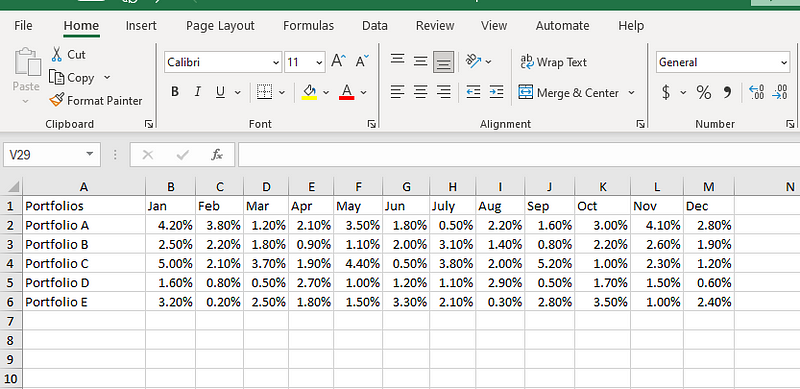
Portfolio returns data.
We’ll calculate the mean for each portfolio (remember that the formula of CV requires us to know the mean). Let’s type the formula below in the cell N2:
=AVERAGE(B2:M2)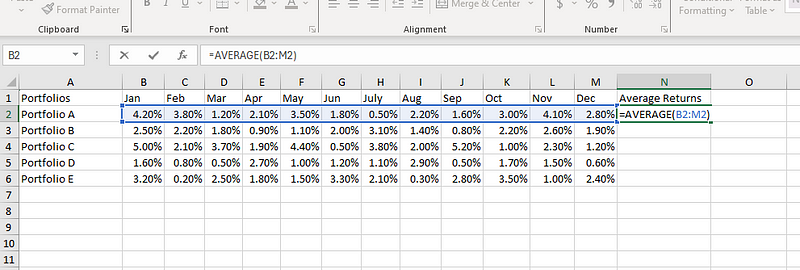
Calculating the mean in Excel.
Now, we drag the fill handle (the small square at the bottom right corner of N2) to extend the formula to the other portfolios.
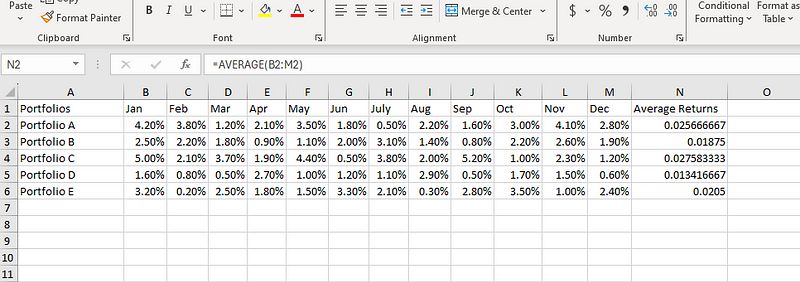
Extending the calculated mean to other portfolios.
We have the mean, but we need another element for our CV formula: the standard deviation. Let’s select O2 and use the following formula to calculate the standard deviation:
=STDEV.P(B2:M2)
Calculating standard deviation in Excel.
We now drag the fill handle to extend the formula to the other portfolios. As a sidenote, we used STDEV.P() instead of STDEV.S() because in our example we’re assuming our dataset is a population instead of a sample.
Now that we have both the mean and the standard deviation, we can calculate the CV. Let’s divide the standard deviation by the mean in P2:
=N2/O2
Calculating the coefficient of variation in Excel.
As before, we drag the fill handle to extend the formula to the remaining portfolios.
Since the CV is typically expressed as a percentage, we select P2 to P6, and change the number formatting to Percentage as shown in the diagram below.
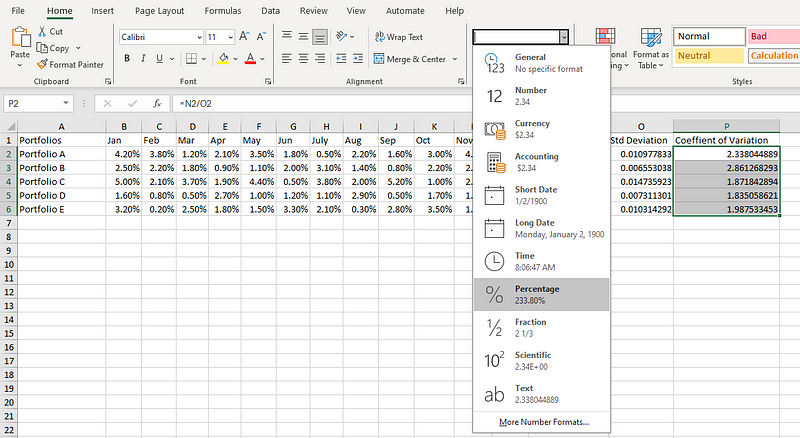
Transforming the values into percentages.
And that’s it, all our CV values are in the P column!

Final data with all calculations.
Learn Excel Fundamentals
Interpreting the Coefficient of Variation
A lower CV indicates that the portfolio has a lower risk per unit of return, suggesting a more stable or consistent performance relative to its average return. A higher CV suggests higher risk per unit of return, implying that the returns are volatile or inconsistent relative to the indicated average returns.
Based on the results above, we could include the following conclusions in our report:
- Portfolio D offers the lowest return and also has the lowest CV, making it potentially suitable for risk-averse investors who prioritize stability over high returns.
- Portfolio B, despite having a moderate average return, has the highest variability (highest CV), which might be suitable only for risk-tolerant investors who can handle significant return fluctuations.
- Portfolio C might be the most balanced choice for many investors thanks to its combination of the highest return and relatively low volatility. It offers a good trade-off between risk and reward.
Coefficient of Variation: Practical Considerations
Now that we know what the CV is and how to calculate it in Excel, let’s take a look at a few practical aspects.
The coefficient of variation with zero or near-zero means
When interpreting CV, we need to watch out for zero or near-zero means. This can happen if all our data points are zero, or if positive and negative values perfectly balance out. In these cases, the CV calculation tries to divide by zero, leading to meaningless results.
Similarly, a very small mean can mislead us. The CV might be extremely high, suggesting high variability, even if the actual spread in our data is minimal. Imagine analyzing investment returns with some slightly positive and some slightly negative values, leading to a near-zero mean. The CV could exaggerate the perceived risk.
For zero or near-zero means, we need to consider alternative measures like range, interquartile range, or just the standard deviation. If you want to learn more about measures of variability, check out this Introduction to Statistics course.
The coefficient of variation and the data distribution
The CV works best when data is normally distributed, or at least symmetrical. If our data is skewed or has outliers, the mean and standard deviation can be skewed, leading to an inaccurate CV.
It's helpful to explore our data using descriptive statistics or visualizations before using the CV. This will help us understand the distribution and identify any skewness or outliers that could affect the CV's reliability.
If you want to use Excel to visualize data, check out this course on Data Visualization in Excel.
The coefficient of variation with ratio and interval scales
The CV is most useful for ratio-scale data with a zero point that truly represents an absence the quantity (e.g., heights, weights, or prices). In these cases, a zero value means actually zero—a weight of zero means there's no weight present.
However, applying CV to interval data like temperatures or dates can be misleading. Their zero point doesn't necessarily mean an absence of the quantity. For instance, zero degrees Celsius doesn't mean there's no heat present.
However, if we perform transformations on temperature data, such as measuring temperature anomalies, where zero means non-existence, then it becomes a suitable use case.
The takeaway is that, before using CV, we need to consider whether our data type aligns with the assumptions of the CV calculation to ensure reliable results.
Conclusion
The coefficient of variation (CV) is a valuable tool for data scientists, offering us a standardized way to compare the variability of datasets even when they use different units. As we've seen, it has applications in diverse fields like finance, manufacturing, and weather analysis.
Calculating the CV in Excel is a straightforward process. By leveraging the built-in functions for the standard deviation and the mean, we can easily calculate the CV.
If you want to power up your data analysis skills in Excel, consider this course on Data Analysis in Excel.
Advance Your Career with Excel
Gain the skills to maximize Excel—no experience required.

As a senior data scientist, I design, develop, and deploy large-scale machine-learning solutions to help businesses make better data-driven decisions. As a data science writer, I share learnings, career advice, and in-depth hands-on tutorials.


